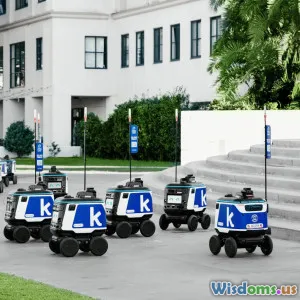
Future of Work: AI and Automation
8 min read Explore how AI and automation are reshaping the future workplace with challenges, opportunities, and strategies for adaptation. (0 Reviews)
Future of Work: AI and Automation
Artificial Intelligence (AI) and automation have been heralded as the twin engines driving a seismic shift in how we work. From factory floors to corporate offices, their influence is expanding rapidly, challenging traditional job roles and opening new horizons for innovation and efficiency. But beyond the buzzwords lies a complex landscape filled with promise and peril. This article delves deep into the future of work shaped by AI and automation, examining real-world impacts, sectoral changes, and what individuals and organizations can do to thrive.
Introduction: A Revolution in the Making
Imagine a workforce where intelligent machines handle routine tasks with unerring accuracy, while humans focus on creativity, problem-solving, and strategic thinking. This is not a distant fantasy but a current trajectory foreshadowed by AI and automation technologies. According to a McKinsey report in 2023, by 2030, automation could displace up to 30% of tasks globally but simultaneously create millions of new jobs demanding advanced technical and social skills.
However, the transition is far from smooth. Questions abound about job security, ethical considerations, and economic inequality. How we navigate this transformation will define the future of work across industries and countries.
The Expanding Role of AI and Automation in Workplaces
Automation Beyond Manufacturing
Traditionally, automation conjured images of robots assembling cars in factories. Today, its scope has expanded vastly:
-
Healthcare: AI algorithms assist in diagnostics, analyzing medical images, and personalized treatment plans — increasing efficiency while improving patient outcomes. For example, IBM Watson Health collaborates with clinicians to identify cancer mutations faster than manual processes.
-
Finance: Automated trading bots execute decisions in microseconds, while chatbots handle customer inquiries at scale.
-
Retail and Logistics: AI-driven inventory management predicts consumer demand, and autonomous delivery drones are piloted as experiments to speed up shipping.
The Rise of Intelligent Automation
Combining AI with robotic process automation (RPA) leads to Intelligent Automation (IA), capable of handling complex, unstructured tasks previously requiring human judgment. Gartner predicts IA will reduce operational costs by up to 30% across industries by 2025.
For instance, in legal services, IA tools can review contracts, flag risks, and streamline due diligence. Midwest law firm Baker Hostetler saw a 60% reduction in document review time after IA implementation.
Workforce Impact: Challenges and Opportunities
Job Displacement Versus Job Creation
While automation threatens certain repetitive roles, it also spurs demand for roles like AI specialists, data analysts, and digital transformation managers. The World Economic Forum's 2023 Future of Jobs report forecasts that 85 million jobs might be displaced but 97 million new roles will be created by 2025, emphasizing a net gain but necessitating retraining.
Skill Shifts and Lifelong Learning
The future workforce must emphasize skills less replicable by machines: creativity, emotional intelligence, critical thinking, and adaptability. According to LinkedIn's 2023 Workplace Learning Report, there’s a 65% increase in investment in soft skills training worldwide.
Corporations like Accenture invest heavily in continuous learning platforms, enabling employees to reskill rapidly as technology evolves. This approach is vital in maintaining employability and organizational competitiveness.
Ethical and Social Considerations
The adoption of AI raises important ethical questions regarding bias, transparency, and surveillance. Ensuring AI systems promote fairness and respect privacy is non-negotiable.
Moreover, automation risks widening social inequalities if access to digital skills remains uneven. Policymakers and businesses must collaborate on inclusive strategies.
Case Studies: Real-World Transformations
Amazon’s Warehouse Automation
Amazon employs thousands of warehouse robots working alongside humans, increasing order processing speed and accuracy. This synergy of man and machine resulted in a 20% productivity boost; however, it has sparked debates on worker safety and job quality.
AI in Customer Service at JPMorgan Chase
JPMorgan uses AI-enabled chatbots to handle millions of daily customer interactions. This frees human agents to tackle complex issues, improving satisfaction rates and reducing operational costs by up to 15%.
Strategies to Navigate the AI-Driven Future
For Individuals
- Embrace continuous learning by enrolling in online courses focused on AI literacy, data analysis, and digital tools.
- Cultivate interpersonal and critical thinking skills that complement AI capabilities.
- Seek cross-disciplinary roles that integrate tech expertise with industry knowledge.
For Organizations
- Invest in workforce upskilling programs tailored to future needs.
- Foster a culture that encourages innovation and openness to technology adoption.
- Implement ethical AI frameworks ensuring transparency and worker well-being.
For Policymakers
- Develop policies supporting displaced workers through retraining grants and social safety nets.
- Promote STEM education accessibility to close the digital divide.
- Encourage collaboration between industry, academia, and government for future-proof labor markets.
Conclusion: Shaping an Inclusive, Adaptive Future
The convergence of AI and automation represents a profound shift with vast potential to boost productivity, innovation, and economic growth. Yet, it also presents complex challenges that require thoughtful action from individuals, organizations, and governments. By embracing lifelong learning, ethical AI principles, and inclusive policies, we can shape a future where humans and intelligent machines collaborate harmoniously, unlocking new opportunities for prosperity and human flourishing.
This future of work is not just about technology — it is about humanity adapting, evolving, and thriving alongside it.
References:
- McKinsey Global Institute. (2023). "The Future of Work After COVID-19"
- World Economic Forum. (2023). "The Future of Jobs Report"
- LinkedIn Learning. (2023). "Workplace Learning Report"
- Gartner. (2024). "Intelligent Automation Market Outlook"
- IBM Watson Health Case Studies
Rate the Post
User Reviews
Popular Posts





















